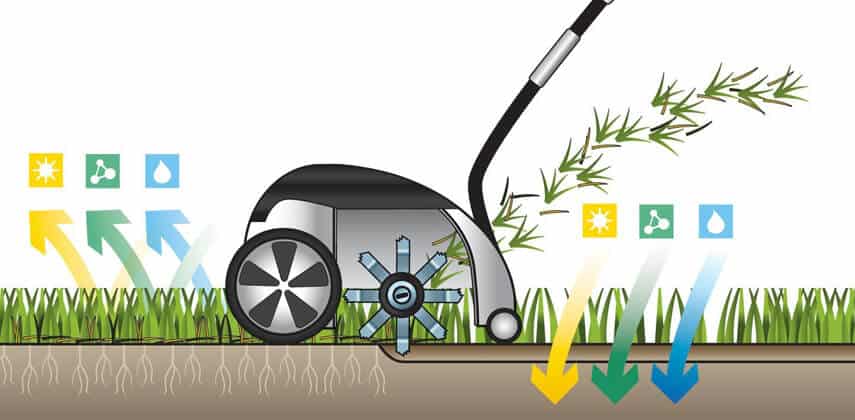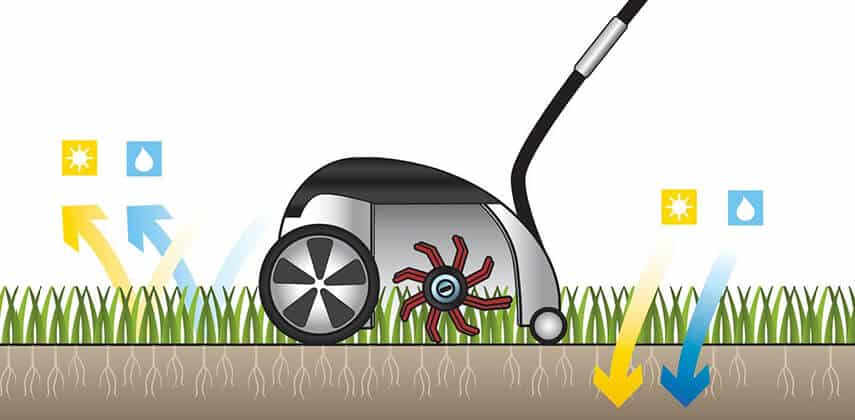Ever wondered what the difference between ‘scarifying’ and ‘raking’ is?
You might have watched videos or read ‘how to’ articles showing you how to scarify a lawn, but they were using a normal garden rake. Sometimes they might be using a powered machine with metal blades.
We aren’t surprised if you’re confused.
What is important is that scarifying and raking are very different lawn maintenance procedures.
Whether you should scarify or rake your lawn depends on;
- The time of year
- The problem you’re trying to resolve or prevent
If you’re wondering what the difference is between scarifying and raking, this article will explain everything.
What Does a Scarifier Do and How Do They Work?
Scarifying or lawn scarification is also known as ‘de-thatching’.
The scarifying process involves removing thatch from just underneath the surface of your lawn using vertical metal blades. You can choose to use either a hand-held tool or a powered machine for this task.
The result is a firmer lawn surface that also allows more air, water and nutrients to penetrate into the soil underneath.
The vertical cutting action of scarifier blades also prunes the shoots and runners of grass plants which encourages new grass growth. This in turn produces a thicker, denser grass sward.
Scarifying also helps to control the growth of shallow rooting weed grasses such as annual meadow grass, as well as unwanted creeping weeds such as speedwell and clovers.
After you’ve scarified, you can also use your scarifier to cut into the soil surface and create the ideal bed for sowing new grass seed.
When to Scarify or Dethatch Your Lawn
Scarifying or de-thatching is much harder on your lawn than raking.
If you have a lot of thatch in your lawn, you could end up with more bare patches than grass when you’ve finished.
To protect your lawn, you should scarify in the autumn when there’s still plenty of heat, sun and moisture combined with fewer weed seeds in the soil.

What Does Lawn Raking Do?
Raking is specifically for the removal of moss from your lawn.
Raking makes use of either a springbok rake or a powered lawn rake which tears moss from the surface of the lawn.
If you’re completing a full lawn renovation, it’s a good idea to rake moss away before de-thatching. This will make the removal of thatch much easier.
Better yet, raking also removes the top layer of dead roots, stolons (stems) and rhizomes from the lawn before it becomes thatch. This alone will ensure that you won’t have to scarify or de-thatch as frequently as this process allows you to control the build-up of thatch.
Raking is also much gentler than heavy scarification, so lawn recovery is quicker.
When to Rake Your Lawn
Because raking is gentler to your lawn than de-thatching, you can do it as often as you require.
Raking in spring and autumn is preferable to remove moss and prevent thatch build up.

A Summary of Scarifying and Raking Tools
Whether you choose to use hand tools or powered tools will depend on the size and overall condition of your lawn.
The manual way is much harder so prepare yourself for the effort involved.
The better tools for both tasks are powered machines with interchangeable cassettes which can rake and de-thatch.
This allows you to complete both tasks with one tool as well as making the process easier and faster.
Consult our guide to the best scarifiers for more information.
Final Verdict
Scarifying or de-thatching should be completed in the autumn and is done to remove thatch from your lawn. We’ve produced a guide which will show you how to scarify your lawn properly.
Raking can be done in spring and autumn and removes moss from your lawn. Raking will also control the build-up of lawn thatch by removing dead grass roots, shoots and runners before they ever become thatch.